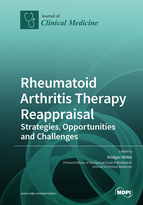Rheumatoid Arthritis Therapy Reappraisal: Strategies, Opportunities and Challenges
A special issue of Journal of Clinical Medicine (ISSN 2077-0383). This special issue belongs to the section "Immunology".
Deadline for manuscript submissions: closed (30 September 2019) | Viewed by 106479
Special Issue Editor
2. Division of Rheumatology and Clinical Immunology, Department of Internal Medicine IV, Ludwig-Maximilians-University, Munich, Germany
Interests: rheumatoid arthritis; treat to target; biological DMARDs; synthetical DMARDs
Special Issues, Collections and Topics in MDPI journals
Special Issue Information
Dear Colleagues,
Rheumatoid Arthritis (RA) is a chronic inflammatory disease leading to joint inflammation and destruction. Treatment of RA includes the use of conventional (cs), biologic (b) disease-modifying anti-rheumatic drugs (DMARDs), and oral or intraarticular (IA) glucocorticoids (GCs). All different classes of drugs have shown to halt disease progression in clinical studies. In real life, a physician has more options than just adding or switching to a new ts/bDMARD if any kind of DMARDs have failed. He can modify or optimize the therapy with concomitant csDMARDs, and oral or IA-GC can be added to the treatment regimen. The EULAR states that therapeutic adjustment including the "optimization of csDMARDs dose or route of administration or intra-articular injections of GCs" is recommended. Thus, a new therapeutic agent can be embedded in a whole strategy with parallel optimization of the csDMARD and GC treatment.
The idea of treating to target (T2T) has been around since the late 1990s for treatment of RA patients. Many clinical studies (Ticora, BsSt, Camera) have demonstrated the superiority of an T2T approach. When I talk to physicians, I understand that most of them only rarely inject joints with GC. Therefore, I would like to create an issue on the T2T approach in reality including primary data, reviews, and real-life data demonstrating the general opinion and the execution on T2T in treating RA.
Dr. Rüdiger Müller
Guest Editor
Manuscript Submission Information
Manuscripts should be submitted online at www.mdpi.com by registering and logging in to this website. Once you are registered, click here to go to the submission form. Manuscripts can be submitted until the deadline. All submissions that pass pre-check are peer-reviewed. Accepted papers will be published continuously in the journal (as soon as accepted) and will be listed together on the special issue website. Research articles, review articles as well as short communications are invited. For planned papers, a title and short abstract (about 100 words) can be sent to the Editorial Office for announcement on this website.
Submitted manuscripts should not have been published previously, nor be under consideration for publication elsewhere (except conference proceedings papers). All manuscripts are thoroughly refereed through a single-blind peer-review process. A guide for authors and other relevant information for submission of manuscripts is available on the Instructions for Authors page. Journal of Clinical Medicine is an international peer-reviewed open access semimonthly journal published by MDPI.
Please visit the Instructions for Authors page before submitting a manuscript. The Article Processing Charge (APC) for publication in this open access journal is 2600 CHF (Swiss Francs). Submitted papers should be well formatted and use good English. Authors may use MDPI's English editing service prior to publication or during author revisions.
Keywords
- rheumatoid arthritis
- treat to target
- biological DMARDs
- synthetical DMARDs







